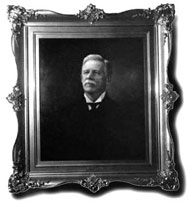
 |
 | |
 9.1 L.R. Evans Portrait of Dr. Isaiah Everhart 1906 Oil on Canvas 36" x 40" Gift of J.J. Jermyn |
Dr. Isaiah Fawkes Everhart was a descendant of one of the oldest and most prominent families in the United States. The earliest of member of the family in the Americas was Zachariah Everhart. Originally from Saxony, Germany, he settled in Pennsylvania nine years after William Penn founded the Colony in 1689. He had three children, William, John, and James. James, the youngest child of James, Sr., was born in 1789 and died in 1863. He served as an officer in the War of 1812. After the war he engaged in the mercantile business in Chester County, Pennsylvania. In 1820 he moved to Berks County, where he became extensively engaged in agriculture, tanning, and the iron trade. In 1817 he married Mary M., the only child of Isaac and Catharine Templin. Dr. Isaiah Fawkes Everhart was the youngest child born to James and Mary on January 22, 1840. He spent his early youth at the family homestead in Berks County, Pennsylvania attending common schools and academies of the neighborhood. At the age of sixteen Isaiah entered the scientific course at Franklin and Marshall College, Lancaster, Pennsylvania, where he graduated with the class of 1861. He learned his first lessons in medicine from his brother-in-law, Dr. Charles A. Heckel, a practicing physician. Shortly after the beginning of the Civil War, he became a medical cadet at West Philadelphia or Saterlee U.S. Military Hospital, then under the charge of Dr. I.I. Hayes of Arctic Expedition fame. Everhart received his Medical Degree with the class of 1863 of the Medical School of the University of Pennsylvania. Immediately after receiving his medical degree in 1863, Dr. Everhart was commissioned as a 1st Lieutenant in the U.S. Military. In that same year he was assigned as an assistant surgeon in the 8th regiment Pennsylvania Cavalry of the Army of the Potomac. Lieutenant Everhart served front line duty for more than thirty battles in which his regiment fought. On February 4, 1865, he was promoted to full surgeon with the rank of Major. Upon the consolidation of his regiment with the 16th regiment Pennsylvania Cavalry on July 24th, 1865, Major Everhart ceased active campaigning and was made Chief Surgeon of the Military District of Lynchburg, Virginia. Major Everhart was honorably discharged from service with the 16th Regiment on August 11th, 1865. At the close of the Civil War Dr. Everhart joined his brother, James M., on an extended tour of Europe visiting major industrial and art centers. In 1868 he took up residence in Scranton, close to family coal lands, and began his career as a General Practitioner which he continued until shortly after 1900. During the great strike in the coal regions of 1871, he served as a surgeon for the 9th Pennsylvania Guard. For a number of years Dr. Everhart was a staff member of Scranton State Hospital, and was on the first Scranton Board of Health. He was a member of the Lackawanna Game and Fish Association in the 1880s, serving as President for several years. He was one of the incorporators and directors of Scranton Forging Company, and had holdings in the Everhart Brass Works and in various family anthracite coal lands. Dr. Everhart enjoyed hunting and fishing and took extended field trips each year to satisfy his hobbies. In 1871 he married Annie Victoria Ubil, the only daughter of Peter and Margaret Ubil whose property adjoined the family homestead. Dr. and Mrs. Everhart had one son, Edwin Ellsworth Everhart. Mrs. Everhart passed away in 1898, and at that time her husband seems to have intensified his interest in ordering and expanding his previously established collections of the natural life from Pennsylvania and in extending his natural history interests into other areas of the world. On February 2, 1907, Dr. Everhart publicly announced his gift of a Museum to the City of Scranton and work was immediately begun on the erection of the Everhart Museum of Natural History, Science and Art. The doctor seemed pleased with his creation at the time of its opening on May 30, 1908, and continued to devote much time to its development until his death on May 25, 1911. |
 |
 |
 |
 |
 |
 |
 |
 |
 |
 |
 |
 |